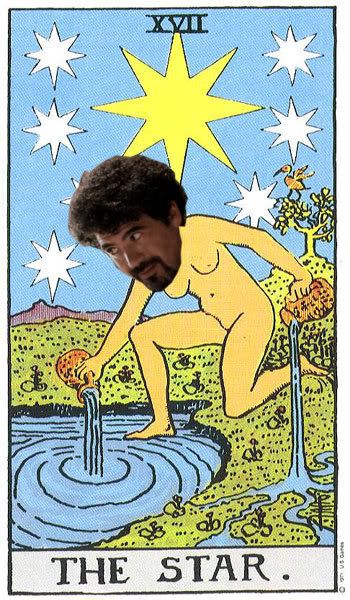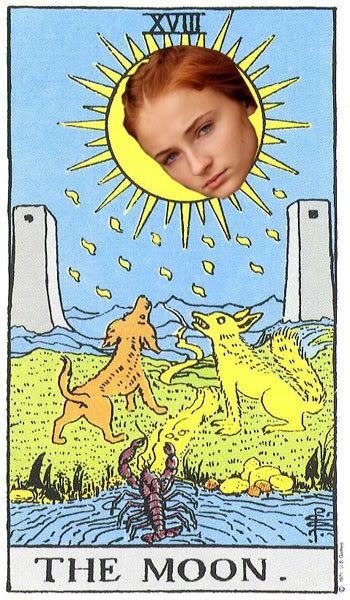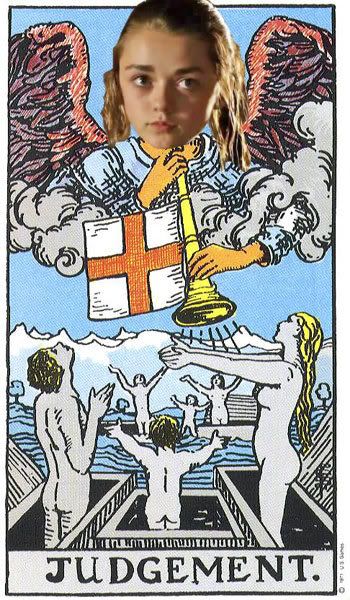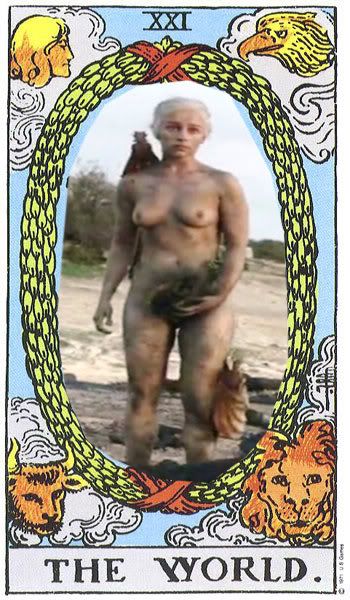SPOILER ALERT: This article presupposes that you have read A Game Of Thrones/watched through the first season of A Game Of Thrones. I will make efforts not to spoil anything past that. (Though I will likely write a separate article that incorporates the entirety of the story thus far.)
XVII The Star - Syrio Forel
XVII The Star - Syrio Forel
This was a tough one. The Star is a character who brings new technology from a faraway place, a Promethean genius who can decipher secret meanings of the heavens. Representing Aquarius, the best fit would be a person who goes against the normal conventions of their area and time, someone that stands out as other or foreign. I briefly considered Theon Greyjoy and Osha, both captive outsiders, before settling on Syrio Forel, Arya’s “dancing master” and the First Sword of Braavos.
Syrio is one of our few major players who is not a native Westerosi (I believe Varys qualifies, as well,) and is the only character I can think of who brings a counter-cultural set of theory and precepts to the continent. Syrio is from Braavos, and unlike Westeros’ reliance on heavy armor and hulking broadswords, the Braavosi rely on lithe, graceful styles of fighting. Syrio calls this “Water Dancing,” and the effect looks something like a combination of fencing and Bujinkan Ninjutsu - certainly nothing like what the knights are practicing, and Syrio is mocked by the men of the land on more than one occasion for his strange and less brutal style of fighting. However, Ned Stark sees Syrio as a gift after realizing that his combat-crazed daughter, Arya, will never quite settle into the needlework and ball gown lifestyle of a proper lady.
Aquarius is ruled by Saturn, a planet which conjures images of authority figures. Instead of bullies and horrible bosses, the Aquarian Fixed Air throws a more innovative and idealistic spin on this image. So we get a kooky instructor, a strange sensei who’s determined to improve his charge, one confusing koan and humiliating beating at a time.
XVIII The Moon - Sansa Stark
“The Moon” is a somewhat confusing title for this card, as it is not given to astrology’s Moon, but to the 12th sign of the zodiac, Pisces. I think the title’s only been preserved because it’s the middle piece out of three celestial elements that grow larger in scope (The Star, The Moon, The Sun.) My teacher once suggested that a better title for this card might be “The Night.”
Anyway. The Moon, at its most basic, is about regression to the primal, and about finding one’s environment suddenly shrouded with darkness and uncertainty. The night is full of unknown predators, strange creatures not seen in the light of day, not to mention the fearsome potential for supernatural ghouls and ghosts a child might imagine lurking in shadow. Faced with such terrors, a person falls back on their survival instinct. The construct of identity is stripped down further and further until only the essential core remains...a regression to the primal.
A lot of fandom hates Sansa Stark. They perceive her as callow, frightened, and ultimately useless. But if you really think about it, Sansa’s the horror movie virgin-heroine doing her level best to survive in a city full of monsters.
Sansa wanted what every lady of her age wants - she wanted to fall in love and marry a charming prince and live happily ever after. She’s built her perception of the world up to an unattainable storybook ideal, and the attainment of her goals seems to be dangling in front of her face. Without any knowledge of the political strife, conspiracies, or back-deal dealing in which her father is entrenched, all that Sansa can see is that her handsome prince Joffrey (remember, she’s delusional) is right there, their families are friends, and it seems completely natural that they should marry. She doesn’t see why her sister and father have to keep screwing things up for her, and because she’s blinded by a vision of her ideal, she’s slow to notice the danger that her family is in and loses her way very quickly.
 |
| Still a Stark. |
However, she’s still a Stark at her core, and the flash of anger in her eyes when Joffrey mocks her father’s corpse shows us that she hasn’t given up. It may not be as obvious as her sister’s method of fighting back, but Sansa has a lifetime of training in the ways of courtly society, a world in which she is now confined as a guest/prisoner. Though she’s surrounded by enemies at all times, she finds her own way to survive and strike back where she can.
XIX The Sun - Brandon Stark & Joffrey Baratheon
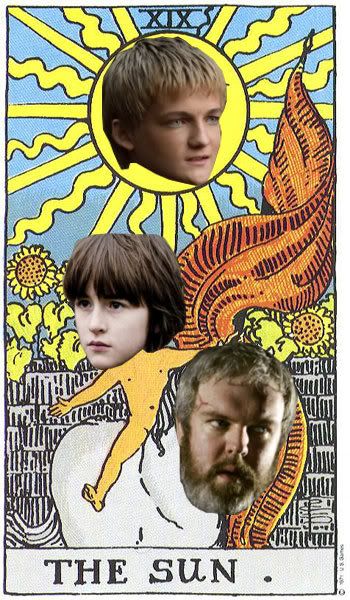 |
| Hodor Hodor! |
Unlike the previous card, The Sun is less confusing. It represents The Sun. That is, identity, childlike wonder and joy, and the ability of the spirit to climb high and persevere in the face of forces that try to keep it grounded. Whereas Death and The Devil both contain messages of matter’s triumph over spirit, we see the opposite here - the spirit is exalted and eternal.
Joff’s here because this card often points to someone who is the center of attention, the regent on whom all things hinge. The Sun has been an astrological marker of kings and rulers for thousands of years, so much so that eclipses were used to fortell their deaths and grievous misfortunes. Joff’s also here to remind us that not all exalted spirits are wonderful things. He’s as unfettered, childlike and gleeful as you could want this archetype to be, but because of his improper rearing, and probably because he’s somehow chemically imbalanced, that “exaltation” translates into Joffrey using the realm of his playset, acting out disgusting atrocities with little regard for their effect on anyone else. The Sun can be a marker of complete self-absorption and lack of empathy, where no one else’s feelings or concerns ever enter into the picture, and Joffrey is that type of person through and through.
But Bran’s the one I really want to talk about here. He’s a joyful little boy with a love for playing and climbing, and all of that gets snatched away from him in an instant when he is thrown from a high tower by Jaime Lannister and crippled. The rest of Bran’s journey seems to be one of pulling himself up from the depths of his despair in order to reclaim a piece of that original joy and wonder. And with his father dead and his Robb off at war, Bran is the man of the house, the defacto regent of Winterfell. Unlike Joffrey, he is tempered by advisors he’s grown up around who encourage him to take this responsibility seriously for the sake of the smallfolk, who need to be reminded that there will always be a Stark in Winterfell.
 |
| The crow is from Springfield...? |
Bran’s obsession with climbing is evocative of the solar predilection with trying to bring oneself higher and higher into the sky, and reminds one of Icarus’ fall. With a very limited ability to explore the physical world, Bran must turn toward matters of the spirit, another solar hallmark, as the Sun is primarily concerned with prophecy and the soul. We see only brief hints of this in the first installment of the story, but it’ll develop more as Bran has more empowering conversations with the Three-Eyed Crow, which is a symbol laden with solar imagery. (It is a sky-dwelling bird with a third eye open to symbolize enlightenment. In fact, Amaterasu, the Shinto Sun goddess, had a three-footed crow as one of her divine symbols and messengers.) More than any other member of his family, Bran also relies increasingly reliant on his direwolf, Summer, who is named for a time when the Sun’s strength is most apparent. It is also worth noting that the direwolves seem to be representative of the Stark kids’ souls, so it makes sense that Bran’s bond would be the strongest.
XX Judgement - Arya Stark
Like themes found in the The Moon, one aspect of this card involves needless pieces of identity being discarded, and like Death, there is an emphasis on inevitability and sometimes on the more grotesque truths of existence. However, Judgement dares one to accept these truths, to stand tall and perform in spite of them. Unlike The Moon, there is an element of inner certainty, a vision for one’s future that transcends simple ambition. This card is reminiscent of Dune’s “Litany Against Fear,” staring fate in the eye and daring it to blink.
Arya Stark has known for a very long time, somewhere deep down, that the path laid out for her would diverge from the path her parents had planned. Uninterested in needlework, boys and gossip, Arya has always preferred the war-like pursuits of her brothers, and has evaded her caretakers many times in order to participate. It’s what she loves and it’s what she’s good at. The only member of her family who has acknowledged the positive aspects of this is her half-brother, Jon Snow, who had the castle’s blacksmith craft a tiny, light, Arya-sized sword, which they together named “Needle,” so that she’d be able to truthfully tell her Septa that she was off to do her “needlework.”
Arya’s action-junkie nature eventually leads her father to find an outlet for her in Syrio Forel, who harnesses Arya’s eager vigor to the training of a Water Dancer. She is with him for only a short time, but manages to absorb the fundamentals of his training enough to become one of the most dangerous little girls in all of Westeros. However, during her escape from King’s Landing, Arya learns the price of the path she’s chosen, as she’s forced to kill a stableboy who meant to capture her. She then lives on the streets of King’s Landing, easily mistaken for a street urchin, until her father is executed and she is sighted in the crowd by Yoren of the Night’s Watch, who has the good sense to take her far away from The Lannisters.
Without spoiling too much, Arya’s journey to becoming Hit Girl is far from over. She’ll be forced to do a lot of things to survive, and in her efforts to simply stay alive, other forces seem to be guiding her to a larger fate. She’ll pass judgement on others and be tried by higher powers herself, as she mutates into something very different. Season Two will see the introduction of Jaqen H’ghar, a vagrant stranger who takes an interest in Arya and sends her further down this path.
It is worth noting that, unlike her sister Sansa, whose direwolf was killed and whose identity is slowly disintegrating, Arya sent away Nymeria for her own safety. While Arya remains wind-tossed for some time, there is still the possibility of a reunion with her wolf, and thus, the reclamation of a piece of her soul. Arya will remain Arya because of this, while the same cannot necessarily be said for Sansa.
(psst...Arya Stark is my favorite character in the series.)
WARNING, INCOMING BEWBS (CLASSY ONEs, BUT STILL PROBABLY NSFW)
XXI The World - Daenerys Unburnt
The World card is the end of the tale the highest point of ascent, and in the Neoplatonic view, the closest one can come to godliness. It is about the completion of a great, seemingly impossible deed by holding true to one’s mission and one’s virtue.
While the Ride-Waite deck shows our little friend, Sophia, dancing in the center of the image, other decks show Jesus Christ or New Jerusalem, the promised land. This is the only double-ruled card, given both to the Earth element and to Saturn, both speaking to the need to make something manifest.
Saturn is about having a mission and a purpose, but not in any internal way. This isn’t about changing a person’s heart or soul, though that may factor into it. This is about creating something amazing that you can touch and see. However, this is the card that really combines all the rest into one...and so, spirit does play a large role, as the great work requires a strong will to manifest. The image of Sophia is meant to represent the quinta essentia, the fifth element (Yes, like Leloo Dallas,) and in fact, the faces on the four corners of the card represent the other four elements. They are also mean to represent the four fixed signs and the four evangelists. Dany evokes this image at the end of the first installment of the story - she’s made something magical manifest in the real world with nothing but a certainty that it would work.
Dany doesn’t just conjure the spirits of some dragons or an illusion. She doesn’t feel dragons in her heart, or become a dragon inside...well, perhaps she does, but that was much earlier in the story. The point is, she hatched real dragons from eggs that were supposed to be inert forever, something that members of her family had been trying to do ever since the dragons were exterminated.
If the story were to end here, one might assume that Dany returned to Westeros with her dragons in tow to turn all the bad guys into ash and create a shining new paradise within Westeros. But...it’s not going to be that simple, as this is only the beginning of the Song of Ice and Fire.
